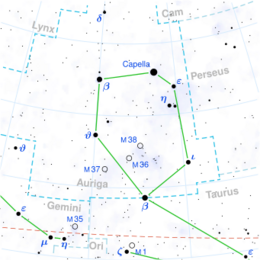Astronomy:HD 40873
| Observation data Equinox J2000.0]] (ICRS) | |
|---|---|
| Constellation | Auriga |
| Right ascension | 06h 04m 29.11992s[1] |
| Declination | +51° 34′ 24.1921″[1] |
| Apparent magnitude (V) | 6.45[2] |
| Characteristics | |
| Spectral type | A7 V[3] or A7 III[4] |
| U−B color index | +0.16[2] |
| B−V color index | +0.196±0.007[5] |
| Astrometry | |
| Radial velocity (Rv) | 19.6±2.9[5] km/s |
| Proper motion (μ) | RA: +1.850[1] mas/yr Dec.: −41.692[1] mas/yr |
| Parallax (π) | 7.1678 ± 0.0962[1] mas |
| Distance | 455 ± 6 ly (140 ± 2 pc) |
| Absolute magnitude (MV) | 0.76[5] |
| Details | |
| Luminosity | 38[6] L☉ |
| Temperature | 7,753[6] K |
| Rotational velocity (v sin i) | 134[7] km/s |
| Other designations | |
| Database references | |
| SIMBAD | data |
HD 40873 is a star in the northern constellation of Auriga, a few degrees to the south of Delta Aurigae. Located around 455 light-years distant,[1] it shines with a luminosity approximately 38 times that of the Sun and has an effective temperature of 7,753 K.[6] It is a suspected variable star[2] and has a fairly rapid rotation rate, showing a projected rotational velocity of 134 km/s.[7] Eggen (1985) suggested it is a probable member of the Hyades Supercluster.[8]
Samuel Molyneux named this star Telescopica in Auriga.[9] Flamsteed catalogued it as 35 Camelopardalis Heveliana, which is the name James Bradley continued to use, although it is within the borders of the modern constellation Auriga.[10] Francis Baily reclassified it to Auriga as star 1924 in the British Association's 1845 Catalogue of 8377 Stars.[11]
HD 40873 is considered to be an Am star, a chemically peculiar star with unusually strong absorption lines of metals.[12] It has been given a spectral type of kA5mA7IV,[13] although other catalogues have given more normal classifications such as A7 V or A7 III.[3][4]
Components
HD 40873 has a 9th magnitude class A5 companion about half an arc-minute away. It is designated as SAO 25549.[14] The companion is itself a pair of stars, each of similar brightness, separated by 0.6".[15]
References
- ↑ Jump up to: 1.0 1.1 1.2 1.3 1.4 1.5 Brown, A. G. A. (August 2018). "Gaia Data Release 2: Summary of the contents and survey properties". Astronomy & Astrophysics 616: A1. doi:10.1051/0004-6361/201833051. Bibcode: 2018A&A...616A...1G. Gaia DR2 record for this source at VizieR.
- ↑ Jump up to: 2.0 2.1 2.2 Danziger, I. J.; Dickens, R. J. (July 1967). "Spectrophotometry of New Short-Period Variable Stars". Astrophysical Journal 149: 55. doi:10.1086/149231. Bibcode: 1967ApJ...149...55D.
- ↑ Jump up to: 3.0 3.1 Abt, Helmut A.; Morrell, Nidia I. (1995). "The Relation between Rotational Velocities and Spectral Peculiarities among A-Type Stars". Astrophysical Journal Supplement 99: 135. doi:10.1086/192182. Bibcode: 1995ApJS...99..135A.
- ↑ Jump up to: 4.0 4.1 Cowley, A. et al. (April 1969). "A study of the bright A stars. I. A catalogue of spectral classifications". Astronomical Journal 74: 375–406. doi:10.1086/110819. Bibcode: 1969AJ.....74..375C.
- ↑ Jump up to: 5.0 5.1 5.2 Anderson, E.; Francis, Ch. (2012). "XHIP: An extended hipparcos compilation". Astronomy Letters 38 (5): 331. doi:10.1134/S1063773712050015. Bibcode: 2012AstL...38..331A.
- ↑ Jump up to: 6.0 6.1 6.2 McDonald, I. et al. (2012). "Fundamental Parameters and Infrared Excesses of Hipparcos Stars". Monthly Notices of the Royal Astronomical Society 427 (1): 343–57. doi:10.1111/j.1365-2966.2012.21873.x. Bibcode: 2012MNRAS.427..343M.
- ↑ Jump up to: 7.0 7.1 Royer, F. et al. (October 2002). "Rotational velocities of A-type stars in the northern hemisphere. II. Measurement of v sin i". Astronomy and Astrophysics 393 (3): 897–911. doi:10.1051/0004-6361:20020943. Bibcode: 2002A&A...393..897R.
- ↑ Eggen, O. J. (June 1985). "A systematic search for members of the Hyades Supercluster. IV - The metallic-line stars and ultrashort-period Cepheids". Astronomical Journal 90: 1046−1059. doi:10.1086/113812. Bibcode: 1985AJ.....90.1046E.
- ↑ Bradley, James; Rigaud, Stephen Peter (1832). Miscellaneous works and correspondence of the Rev. James Bradley, D.D., F.R.S.. Oxford University Press. p. 212.
- ↑ Wagman, M. (1987). "Flamsteed's Missing Stars". Journal for the History of Astronomy 18 (3): 209–223. doi:10.1177/002182868701800305. Bibcode: 1987JHA....18..209W.
- ↑ British Association for the Advancement of Science; Francis Baily (1845). The Catalogue of Stars of the British Association for the Advancement of Science: Containing the Mean Right Ascensions and North Polar Distances of Eight Thousand Three Hundred and Seventy-seven Fixed Stars, Reduced to January 1, 1850: Together with Their Annual Precessions, Secular Variations and Proper Motions, as Well as the Logarithmic Constants for Computing Precession, Aberration and Nutation. With a Preface Explanatory of Their Construction and Application. R. and J. E. Taylor. pp. 2–. https://archive.org/details/cataloguestarsb00esqgoog.
- ↑ Renson, P.; Manfroid, J. (2009). "Catalogue of Ap, HGMN and Am stars". Astronomy and Astrophysics 498 (3): 961. doi:10.1051/0004-6361/200810788. Bibcode: 2009A&A...498..961R.
- ↑ Gray, R. O.; Garrison, R. F. (1989). "The Late A-Type Stars: Refined MK Classification, Confrontation with Stroemgren Photometry, and the Effects of Rotation". The Astrophysical Journal Supplement Series 70: 623. doi:10.1086/191349. Bibcode: 1989ApJS...70..623G.
- ↑ "CCDM J06045+5135BC". SIMBAD. Centre de données astronomiques de Strasbourg. http://simbad.u-strasbg.fr/simbad/sim-basic?Ident=CCDM+J06045%2B5135BC.
- ↑ Mason, Brian D.; Wycoff, Gary L.; Hartkopf, William I.; Douglass, Geoffrey G.; Worley, Charles E. (2001). "The 2001 US Naval Observatory Double Star CD-ROM. I. The Washington Double Star Catalog". The Astronomical Journal 122 (6): 3466. doi:10.1086/323920. Bibcode: 2001AJ....122.3466M.
 |


